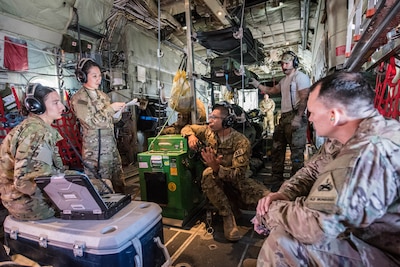By Air Force Master Sgt. Philip Speck 379th Air
Expeditionary Wing
AL UDEID AIR BASE, Qatar, Jan. 18, 2018 — The 379th
Expeditionary Aeromedical Evacuation Squadron deployed here is one of only two
aeromedical evacuation squadrons in the U.S. Central Command area of operations
available to remove wounded warriors from the battlefield and ensure they get
the medical care they need.
Air Force Lt. Col. Julia Moretti, commander of the 379th
EAES, said the unit’s job is to transport wounded warriors from a lower to a
higher echelon of care.
“We take them from the battlefield all the way home,”
Moretti said.
If military personnel are wounded or become ill on the
battlefield, they initially receive first aid care. If lifesaving surgery is
needed, the patients are flown to the nearest hospital abroad. That is where
the 379th EAES comes in. The unit brings the injured service members here. If
they require more intensive care, they will then be transported to Landstuhl
Regional Medical Center in Germany. And as a last resort, they will then go
back to the United States if they can’t be fully treated overseas.
“The goal is to keep them at the lowest level of care, rehab
them and then get them back into the fight quickly as possible,” said Air Force
Senior Master Sgt. Matthew Ausfeld, the 379th EAES first sergeant.
Critical Care Air Transport Teams
In addition to its aeromedical evacuation teams, the
squadron also has critical care air transport teams -- specialized medical
teams composed of a doctor, an intensive care nurse and a respiratory
therapist.
If patients can be treated and return to work while
deployed, they will stay in the theater. But if they have a more severe
condition and could not physically manage doing office work as they recover,
they will return stateside.
As the war has progressed, the severity, type and numbers of
injuries have decreased significantly. In the early 2000s, the teams would care
for 20 to 30 patients who would require litter transport. “Now, that is the
exception, and we’re glad to see we aren’t having that many now,” Moretti said.
Aeromedical evacuation teams are made up of two nurses and
three medical technicians, all considered flight crew. On top of the medical
expertise they must know and practice, they also need to know all about the
aircraft they are flying on. They have to know how to put together seats,
install stanchions to hold patient litters and how the electricity works for
their machines aboard the aircraft, among many other details.
AE teams are also required to have the knowledge to perform
their duties on a wide variety of Air Force aircraft, such as the KC-135
Stratotanker, C-130 Hercules, C-17 Globemaster III, C-5 Galaxy and C-21.
Total Force Partnership
The AE teams here exemplify total force integration; active
duty, Air Force Reserve and Air National Guard members combine to create the
medical teams. In fact, only a small percentage of the teams are made up of
active duty service members.
“The Guard and Reserve components are a key part in the
aeromedical evacuation world,” Moretti said. “Around 88 percent of AE is Guard
and Reserve augmenting active duty. It’s a team effort with all the components
to transport and care for our wounded warriors.”
Moretti and Ausfeld said the job is rewarding.
“It’s a great feeling helping our wounded warriors,” Moretti
said. “Taking care of our own that were injured or became sick while protecting
us, it’s a small way to give back. We pamper the patients and give them the
best tender loving care we can.”
“I've moved wounded warriors around the world, some with
severe battle injuries,” Ausfeld said. “They'll look you in the eyes and thank
you for what you're doing for them. It can catch you off guard, and it can be
hard to respond to. Because these warriors -- these sons, daughters, mothers,
fathers, brothers and sisters -- have sacrificed their body and soul. We're just
making sure they get home.”










